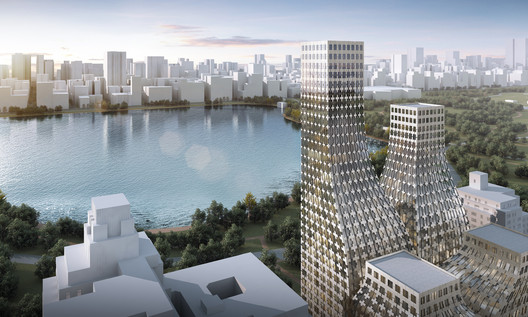
The New York Times recently reported that over 40% of the buildings on the island of Manhattan wouldn’t be granted construction permits in 2017. Most of the culprits date back to the early 20th century when attitudes towards density, ceiling heights, column placement, and general living standards were different. This begs the question: what would modern iterations of New York’s signature structures look like today? Billed by the practice as “an obsessive-compulsive study of the city we love” HWKN’s New(er) York is a peculiar experiment that tackles this hypothetical.

To do this, the architecture firm set out to transform 12 landmark art deco and gothic revival buildings throughout the borough. Their process of modernization took place in four steps: first, HWKN created a highly detailed 3D model of the existing structure. Next, the building’s most intricate features were removed so that only its form and proportions remained. Then, the structure’s massing was reimagined to “emphasize each building’s unique character.” Finally, HWKN dressed the new shape in “contemporary facade techniques” to add a layer of realism to the mockups.

Whether one finds the exercise intriguing or blasphemous, it’s difficult to make the case that New(er) York is anything but a fascinating look into the personality of these projects. The original form of these art deco icons was largely shaped by New York's 1916 Zoning Law. The ordinance encouraged “wedding cake” architecture by requiring no more than 25% of a building’s footprint to extrude skyward in order not to cast intrusive shadows on the street level. This fed art deco’s propensity for wide pedestals and gracefully tapering towers. Because of this, HWKN’s iterations tend to take on an abstracted Minecraft-esque aesthetic.

The final products vary greatly in recognizability, as they’re intentionally devoid of the building’s original embellishments—which are often the components that make these landmarks so memorable. Without their intricacies, gilding, and ornamentation, the Empire State, Woolworth, and One Wall Street buildings all resemble cubistic renditions of their source material, while 30 Rockefeller Plaza remains fairly similar to the original.

While these thought-provoking renders are entertaining, some are more successful than others. The topographic tapering and trapezoidal windows of the reimagined One Wall Street are an arguable improvement over the source material, for example, but HWKN’s take on the Upper East Side’s Eldorado resembles a homely lovechild of 432 Park Avenue and an inverted Eames table.
Below are HWKN’s transformations of One Wall Street, The Eldorado, and 214 West 29th Street:



























